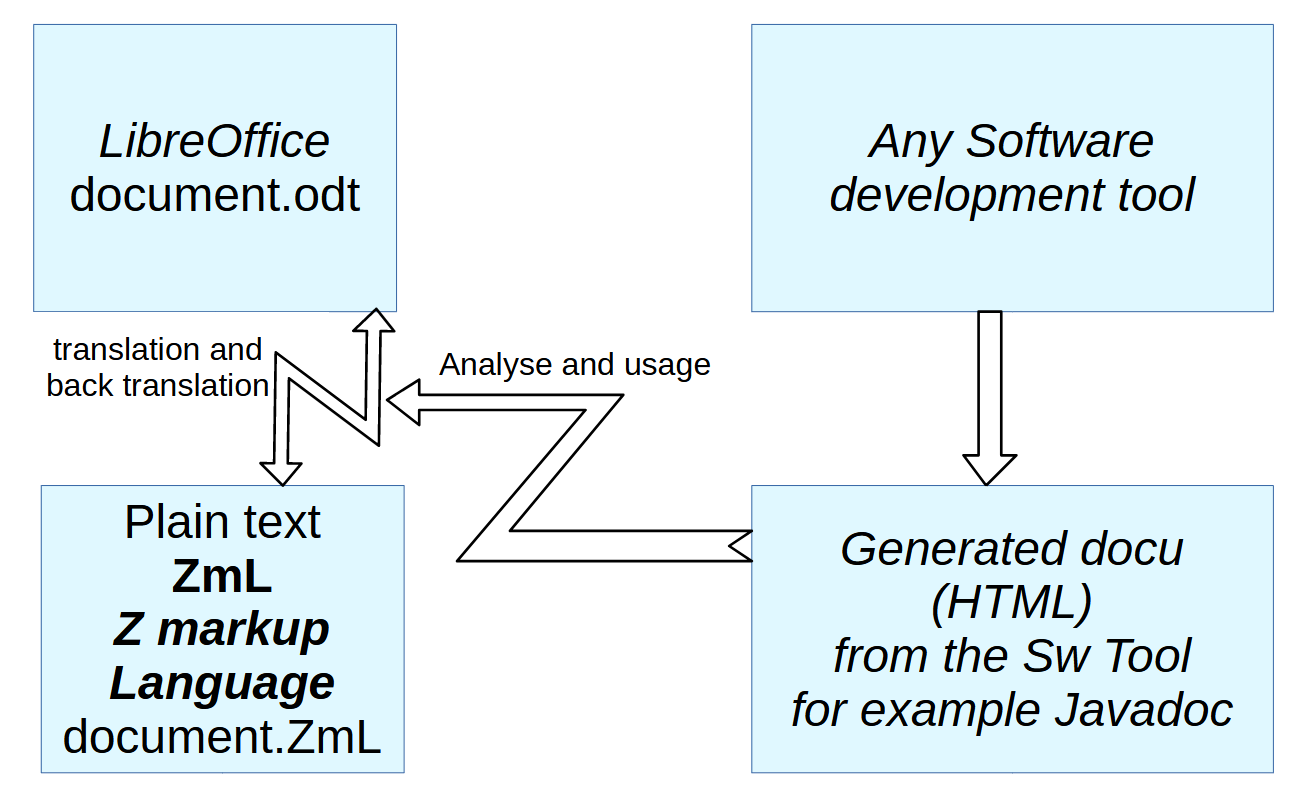Some download zip file which contains all files to reproduce the content in the videos and have own experience is contained in
-
https://vishia.org/LibreOffc/deploy/TemplateZmLodt-2024-10-08.zip: Contains one document as template with all styles and a small explanation inside, the tools, and also generated pdf and html.
-
https://vishia.org/LibreOffc/deploy/LibreOffcZmLConv-2024-10-09.zip: Contains also the sources and the full documentation
Note: This file contains the javadoc for srcJava_vishiaLibreOffc immediately as example to work. The javadoc should also able to download adequate load_tools from www in later versions, so that the zip file will be very more less for future versions. Look for the javadoc also to https://vishia.org/LibreOffc/docuSrcJava_vishiaLibreOffc/index.html
changes since 2024-08:
-
Include of sources now implemented
-
refactoring handling: Button in LibreOffice ⇒ZmL
-
More support supplement targes in linked html docu
The Tools may be loaded also starting src/load_tools/+checkAndLoadTools.bat with the given check sum from the https://vishia.org/Java/deploy directory, or for experience also newer versions can be loaded from there, recommended also with check sum (copy and change +checkAndLoadTools.bat).
This is a experience versions, no warranty. This side will be updated time to time with newer versions.
A documentation can be viewed or downloaded in
-
LibreOffcZMarkup.html … The same document parallel generated as Asciidoc. Here some mistakes may contain in, because while developing, it was not in focus.
1. First video translation in both direction
ZmL maps the LibreOffice.odt content.
This first video (6 min, 63 MByte, 1.4 MBit/s) shows, how translation from a LibreOffice writer odt file to ZmL plain text markup language and back again is done.
Maybe hint for usage: Direct formatting is not supported for common usage ( only used for some specifics).
The conversion from LibreOffice.odt to VmL uses a icon-button and macro in LibreOffice, which calls a batch file (Windows). Linux support is yet not done (instead using a shell script), but will be done in near future.
The conversion from ZmL to LibreOffice.odt is done starting a prepared batch file. The 'content.xml' inside LibreOffice.odt is completely new generated and replaced.
2. Approaches for software documentation
This video (2 min, 25 MByte, 1.7 Mbit/s) shows the approaches for software documentation. In a manual written documentation it should be described not how the software works, but why of the software approaches, the concepts. From this manual documentation the automatic generated documentation should be referred (html link). The automatic generated documenatation, here Javadoc, is elaborately and complete, explain how it works.
Both approaches should be work together.
Another video same topic: ../videos/ZmL-SwDocApp2.mp4 1:15 min, 13 MByte, 1.4 Mbit/s
3. Changing the concept of the working tree, changing link directories in the LibreOffice-docu
This video (6:30 min, 69 MByte, 1.4 MBit/s) shows how to correct paths for links in ZmL. Sometimes there are reasons to change the relations where the automatic generated documentation is stored, absolutely (Internet link) or relative to the pdf or just odt manual documentation.
Because there are many links, all should be corrected, it is a elaborately painful work. That must not be. The video shows, how in VmL this correction is done on plain text source level with search 'n replace, and after them the LibreOffice.odt is simple newly generated.
4. Supplement target labels to the generated docu (Javadoc)
This longer video (11:30 min, 120 MByte, 1.4 Mbit/s) shows why and how target labels to the automatic generated software documentation are replaced while translating to odt. The effort to maintain the sometimes long and sophisticated labels can be saved by this automatic replacement. This approach is done especially for Javadoc, but can be done in a similar kind also for other accesses to generated software documentations.
5. Old:
This second video (16 min, 207 MByte, 1.7 Mbit/s) shows with another, a larger document (yet 140 pages) which formatting approaches, especially indirect formatting, are used and how it is written in the specific VML (Vishia Markup Language).
Hint for the file tree in the example: The generally approaches for the file tree are described in ../../SwEng/html/srcFileTree.html.
It means here:
Working_tree_where_zip_is_unpacked
+-tools This is created after src/load_tools
+-src The sources, only this directory is contained in the zip
+-load_toos To load the translation tools from vishia page
+-srcJava_vishiaLibreOffc It is the originally part from the source tree:
| +-java contains also the sources for the tool.
| +-img Thhis are the images used in the odt
| +-docuSrcJava_vishiaLibreOffc this contains the generated Javadoc from the sources,
| means the folder is complete as used in the software
| +-odt This folder contains the documentation in libre office and the scripts to work with it
| +-asciidoc This folder contains the Asciidoc stuff, it is originally
|
+-example This contains an empty document but with some indirect styles used here.
+-odt You can copy it to write your own document.
+-asciidoc and the additional Asciidoc support
How load the tools for the example:
Generally the tools are contained in https://vishia.org/Java/deploy with jar, source.zip with reproducible build approach and with an MD5-checksum.
The src/load_tools contains a batch file and a tools.bom with the correct check sum. Start the batch file one time. The minisys.jar contains the minimal effort for tool loading.
You need java (version 8 Oracle, or Open Java) to run.




